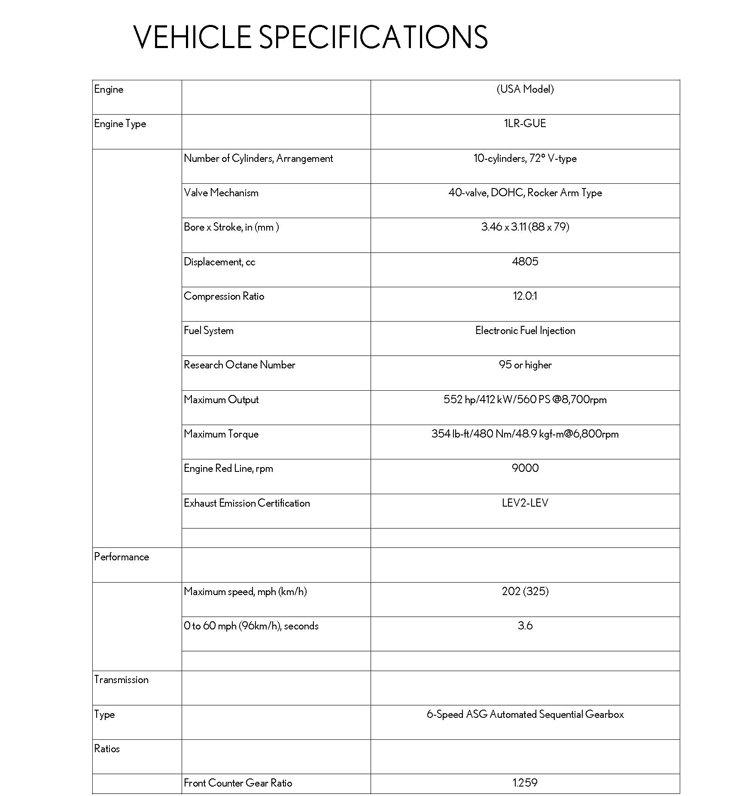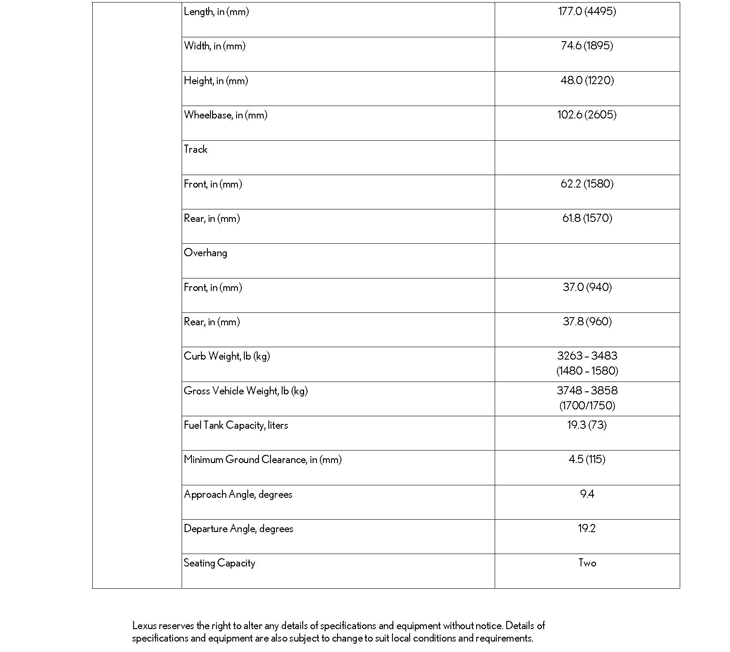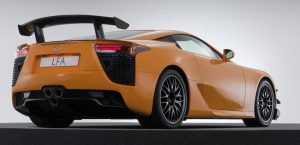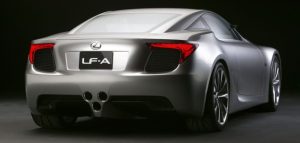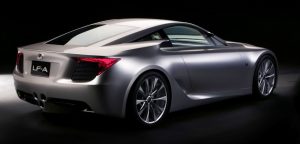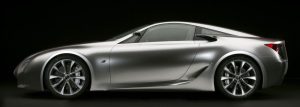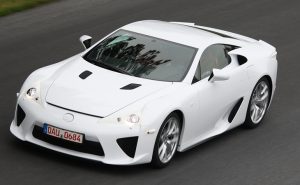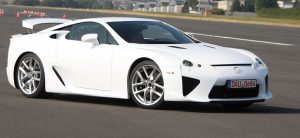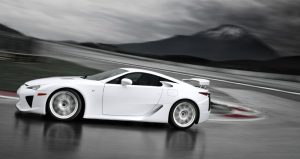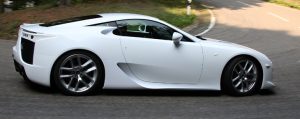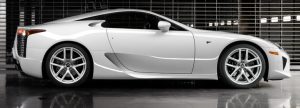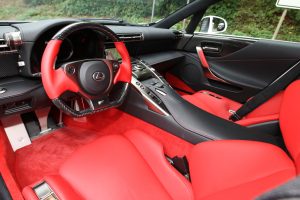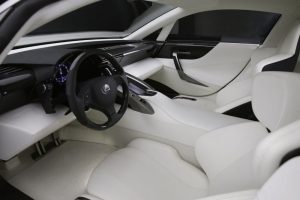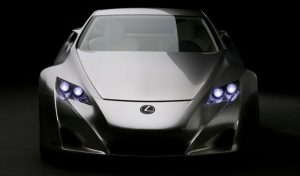
The LFA marks a watershed point for Lexus – its global debut marks the spectacular arrival of a new flagship for the F portfolio of Lexus performance models. A Lexus that single-handedly creates new boundaries to redefine the supercar for the 21st Century.
“From the very beginning of automobile history, supercars have represented dreams, hopes and aspirations,” explained Haruhiko Tanahashi, chief engineer of the LFA’s development program. “For Lexus, a brand that aims to provide customers enlightened moments and memorable experiences, the development of a world-class supercar was an indispensable next step”.
That indispensable next step centered on the creation of a supercar that would deliver the supreme driving experience. To achieve this uncompromising goal, Tanahashi and his team created the LFA from scratch – a true clean-sheet design. And in a radical departure from standard Lexus development practice, they approached the LFA from a non-traditional angle, pushing their technological, material and engineering boundaries at every step.
The result is the rear-wheel drive LFA, a dynamically styled supercar powered by a sophisticated new highrevving 4.8-liter V10 engine that generates 552 hp (412kW/560DIN hp) and 354 lb-ft (480Nm) of torque for adrenaline-fuelled 202 mph (325km/h) performance. This specially-developed powerplant is hooked up to a unique six-speed Automated Sequential Gearbox (ASG) with paddle shifters for ultimate driver control. Linked by a rigid torque tube for excellent drivetrain integrity, the ASG is located in a transaxle layout over the rear axle for an optimal 48:52 front-to-rear weight distribution.
Lightweight, powerful and balanced, the Lexus features advanced Carbon Fiber Reinforced Plastic (CFRP) construction for its chassis and bodywork to deliver a light, incredibly strong and impact-resistant structure.
Rather than out-source this sophisticated materials technology, in a radical move, the LFA team developed its own CFRP processes internally for ultimate quality control and to make a sound engineering investment in the future.
Motorsport-developed lightweight aluminum alloy suspension component is complemented by Carbon Ceramic Material (CCM) brake discs and an innovative electrically assisted rack and pinion steering. The LFA driver sits in low-slung cabin that is as painstakingly constructed as it is driver focused, with every key control perfectly positioned and every creature comfort catered for.
“The LFA is a thoroughbred supercar, a machine engineered to achieve one single goal – to deliver a supreme driving experience,” explained Tanahashi. “Over the past decade we have pushed every boundary in the pursuit of this goal. I believe that we have created the most driver-oriented car we possibly could.”
SUMMARY
- Global debut of the Lexus LFA – a thoroughbred supercar developed solely in the pursuit of the supreme driving experience
- Clean-sheet design and development undertaken by an elite Lexus engineering team
- Singular focus on lightweight carbon fiber construction, dynamic balance and usable 202 mph (325km/h) performance
Production limited to 500 models world wide, each being hand-assembled, with no more than 20 models assembled each month
The LFA is a car of firsts. It is the first supercar developed by Lexus to meet and exceed the company’s exacting standards, and it is the first supercar that is as dynamic and engaging around the Nrburgring Nordschleife as it is tackling a favorite mountain pass. Featuring advanced carbon fiber technology, a highrevving 552 hp (412kW/560DIN hp) 4.8-liter naturally aspirated V10 engine and rear-mounted six-speed sequential transmission, the mid-front engine LFA combines lightweight construction and ideal chassis balance to deliver exhilarating and usable 202 mph (325km/h) performance.
“The LFA is a thoroughbred supercar, a lightweight, powerful and balanced machine engineered to achieve one single goal – to deliver a supreme driving experience,” explains Haruhiko Tanahashi, chief engineer of the LFA’s development program. “Over the past decade we have pushed every boundary – including the development of our own cutting edge carbon fiber monocoque chassis and bodywork – in the pursuit of this goal. I believe that we have created the most driver-oriented car we possibly could.”
Painstakingly developed from a blank canvas by a small and dedicated team of hand-picked engineers that pushed every possible dynamic boundary, the LFA is a halo model for the F performance marquee. The Lexus F brand complements the core Lexus DNA by emphasizing serious performance and de-emphasizing Lexus’ traditional attributes of NVH and comfort. The LFA therefore not only redefines the 21st Century supercar, but also reinforces a new framework for Lexus and its advanced approach to automotive development.
“Ever since the LFA project was started in 2000, my team and I have been driven by a passion to create a world-class supercar, a car to make Lexus proud,” said Tanahashi. “For Lexus – a brand that aims to provide customers with enlightened moments and memorable experiences – the development of a world-class supercar with real visual drama was an indispensable next step.”
In 2000, Tanahashi and his close-knit team embarked on one of the greatest engineering challenges Lexus had ever faced. The project would focus their minds on new technologies, new materials and new processes as they strove to create the car they envisaged, irrespective of the difficulties they encountered in the process. In doing so they would create a dynamic new approach point for Lexus, which would recalibrate the company’s approach to the design of all its models.
Weight-saving measures were taken at each and every step of the LFA’s development. They include innovative Carbon Fiber Reinforced Plastic (CRFP) monocoque chassis and bodywork – a world first for Lexus – as well as carbon ceramic material brake discs, and extensive use of aluminum, titanium and magnesium in the powertrain and transmission assemblies. Even the steering wheel employs carbon fiber elements to make it lighter and more natural in its responses – a typically driver-centric detail of the LFA.
With a low 3,263 lbs (1480kg) curb weight, the LFA steps confidently into the supercar arena with an effective power to weight ratio of 6 lb/hp (378DIN hp/278 kW per tonne). “The LFA is a car with relentless power delivery and an accompanying exhaust note to give you goose bumps,” enthused Tanahashi. “It successfully brings together motive performance, measured by times and graphs, and emotive power – that inexpressible performance that can only be felt in one’s heart and soul. While conventional cars focus on the destination, the LFA is all about the journey.”
Only 500 LFA vehicles are planned for production, all hand-assembled by “Lexus LFA Works” at the Motomachi Plant in Toyota City by skilled technicians at a rate of no more than 20 per month. “Although these inspirational, dreamlike moments will unfortunately only be experienced by a lucky few,” said Tanahashi, “I firmly believe the spirit of the LFA will be the pride of any Lexus admirer.”
POWER AND PERFORMANCE
CARBON FIBER REINFORCED PLASTIC CONSTRUCTION
- Radical rethink sees LFA switch from aluminum to Carbon Fiber Reinforced Plastic (CFRP) construction to achieve exceptional dynamic integrity and performance-enhancing light weight construction
- A trio of sophisticated CFRP molding processes for an impressively low 3,263 lb (1480kg) curb weight – an estimated 220 lb (100kg) saving over an equivalent aluminum construction
- CFRP technology pioneered internally by an elite team of materials engineers to meet Lexus’ exacting standards
- Pursuit of the new technology results in an advanced new joining process for CFRP and metal alloys
- Internal development means this world-class quality CFRP production process is primed for future mass production applications
According to Tanahashi, one of the LFA’s key defining elements was the need to keep the car’s overall weight to an absolute minimum. This resulted in a dramatic decision during the LFA’s development life to switch from aluminum construction to an advanced Carbon Fiber Reinforced Plastic chassis and bodywork.
This move was made even more challenging by Tanahashi’s decision to develop the LFA’s sophisticated CFRP structure in-house, rather than call on a third-party supplier. This ground-breaking assessment – one that fell directly in line with the ethos behind the LFA of tackling new and advanced material and production processes – was taken with an eye on the past, and the future.
Toyota Motor Corporation’s (TMC) heritage as one of the world’s most advanced textile weaving companies created a vital historical resource that Tanahashi’s team drew on when developing the LFA’s CFRP structure.
Historically, the groundbreaking development of the automatic weaving machine by Toyota Motor Corporation not only made a significant contribution to Japan’s economy by producing high-quality fabric at lower costs, but also made a vital contribution to society as a whole.
In a similar manner, the radical switch to CFRP production for the LFA’s development pushed the technical boundaries as the engineers moved from TMC’s traditional weaving looms to the sophisticated three-dimensional carbon fiber looms. As well as reaping the technological benefits of this progress, the use of lightweight CFRP material over heavier metals also reduces the LFA’s impact on the environment.
A striking example of the benefit Tanahashi and his team extracted from Toyota Motor Corporation’s weaving heritage was the development of the company’s broken thread detection technology incorporated into its original fabric weaving looms. Updating the mechanical thread sensors with incredibly accurate laser technology to monitor fabric integrity not only gave the team a crucial insight into the weaving process but also saved critical development time.
At four times the specific strength of aluminum, not only would the CFRP center section create an exceptionally stiff and strong structure, it would also deliver major weight savings, reducing body weight by more than 220 lb (100kg) over an equivalent aluminum body. Working with CFRP would also significantly reduce the lengthy manufacturing time for the LFA’s component. The decision to develop its own CFRP materials technology would also ensure the quality of the carbon fiber used met with Lexus’ own stringent standards.
Unlike the handful of performance vehicles that feature CFRP construction, the advanced resin technology used in the LFA’s chassis is the same employed in today’s most cutting-edge aerospace programs, favored for its unmatched weight and strength qualities. This extensive use of CFRP accounts for 65 percent of the LFA’s body-inwhite weight, with aluminum alloys comprising the remaining 35 percent. Lightweight CFRP was even used for the hood support strut, replacing the traditional, and heavier, hydraulic hood struts.
Three different CFRP forming processes were employed in the structure, used according to their dynamic load, form structure and location. The expensive and labor-intensive Prepreg hand-laid process, where carbon fiber sheets impregnated with liquid thermosetting resin are moulded, heated and pressed in a furnace, was primarily used for the cabin to create a hugely stiff and stable structure.
CFRP for the integrated floor panel and transmission tunnel, roof and hood was produced using the Resin Transfer Moulding (RTM) process, where liquid resin is impregnated into dry preformed carbon fiber before being heated and cured. And the C-SMC Carbon fiber-reinforced Sheet Moulding Compound process, where short fiber materials are hot-pressed in a die, was used to manufacture the C-pillar and its supports as well as the rear floor.
And in a move that underlines TMC’s origins as one of the world’s most advanced textile weaving companies – a vital historical resource that Tanahashi’s team drew on when developing the LFA’s CFRP structure – the undersides of both the hood and hood lid were left unpainted to leave the bare CFRP on display.
As well as pioneering the use of CFRP at Lexus, the LFA team also focused their attention on how best to join the carbon fiber and metal components – traditionally a complicated process. Most joining process use threaded aluminum insert that is wrapped in the CFRP, but the LFA team decided against this method. It developed an innovative system quite different to traditional methods. Requiring no threaded aluminum insert or direct CFRP contact, it employs a flanged aluminum collar to link the two materials and overcome the inherent weaknesses in such joints.
While this switch to CFRP construction pushed back the LFA’s market debut, it was exactly the kind of evaluation embodied by the spirit of the LFA team: to push any and all new boundaries in the pursuit of excellence. The result was that within a short three-year period, the engineers not only mastered carbon fiber production for the LFA but also developed groundbreaking new processes to create a new LFA that was stronger, stiffer and lighter than any metal-based alternative could ever be.
Drawing on TMC’s legacy of weaving and loom-making experience to develop the CFRP has also created a deep and rich pool of internal engineering talent, a technological resource that accelerated the development of the LFA.
Capitalizing on an internally developed automated production system, this world-class quality carbon fiber production process is now primed for future mass production, and will prove invaluable when it comes to work on future Lexus projects.
ENGINE
- Breathtaking performance from an all-new 4.8-liter V10 powerplant rich in motorsport technology
- High-revving engine develops an exceptional 552 hp (412kW/560DIN hp) at 8700rpm and 354 lb-ft (480Nm) of torque at 6,800 rpm
- Rear-wheel drive LFA rockets to 60 mph (96km/h) in 3.6 seconds and has a top speed of 202 mph (325km/h)
- Low-friction powerplant features motorsport-developed independently controlled throttle body for each cylinder and dry sump lubrication
- Front-mid engine V10 is smaller than a traditional V8 engine and as light as a conventional V6 engine yet generates 115 hp (85.7 kW/117DIN hp) per liter
“What we needed – and what we have created – is a car that moves the driver in more ways than one,” explained Tanahashi. “The LFA is a car that stirs all the senses.”
At the heart of the LFA lies a specifically developed V10 engine that sets new automotive standards for compact dimensions, lightweight architecture and scintillating performance. From the outset, Tanahashi and his engineers determined the LFA’s front mid-mounted powerplant would have a 4805 cc capacity, would develop 552 hp (412kW/560DIN hp) and rev to a wailing 9,000rpm redline. It would feature a 72 angle between cylinder heads – the perfect angle for both primary and secondary balance in a V10 engine for incredibly smooth running characteristics. It would be naturally aspirated for a linear and predictable power delivery, with exceptional throttle response from individual, electronically controlled throttle bodies for each cylinder.
It would feature a dry sump lubrication system that would not only position the block deep within the engine bay to lower the center of gravity and lower the car’s moment of inertia, but also enable the engine to handle sustained, high-speed cornering. And it would deliver exceptional mid-range responsiveness as well as a powerful top-end performance.
The V10 powerplant generates 354 lb-ft (480Nm) of torque at 6,800rpm. The application of VVT-i variable valve timing with intelligence on both intake and exhaust combined with equal length exhaust manifolds and highvolume 12-hole fuel injectors results in 90% of this formidable torque being available between 3,700rpm and the 9,000rpm red line, for searing in-gear acceleration at any engine speed and in any gear. The result is a 0 – 60 mph (96km/h) time of just 3.6 seconds and a top speed of 202 mph (325km/h) – exhilarating performance from a bone fide supercar.
With a low 3,263 lb (1480kg) curb weight – achieved by the extensive use of lightweight Carbon Fiber Reinforced Plastic (CFRP) for the chassis and bodywork – and an explosive 412kW/560DIN hp, the LFA steps into the supercar arena with a heady power to weight ratio of 278 kW/378 DIN hp per tonne. The combination of a high, 12:1 compression ratio, low friction internals and optimised intake and exhaust flow results in the LFA’s powerplant developing an exceptional 85.7 kW/117DIN hp per liter, one of the highest specific outputs amongst the current crop of supercars.
Alongside the low weight vital, the key to achieving these incredible goals was the use of exotic and innovative materials including titanium and magnesium, an unwavering focus on low inertia and, wherever possible, the exploitation of cutting-edge motorsport technologies.
Naturally, the valvetrain came under intense scrutiny, and as a result, the engine’s cylinder head features elements more likely to be found on a race car than a grand touring coupe. Titanium valves and connecting rods – a full 40 percent lighter than the equivalent iron and steel component – are complemented by ultra-lightweight solid rocker arms with Diamond-Like Carbon with Silicon coating and integrated oil jets.
Further track-inspired highlights include forged aluminum pistons, low-inertia cylinder-shaped valve springs wound from elliptical rod, a fully integrated lightened crankshaft with paired cylinder valleys designed to reduce pumping losses and a magnesium alloy cylinder head cover. A dual air intake-system also enhances engine performance, switching from a primary inlet port at low to medium engine speeds to dual ports at higher revs to boost breathing efficiency.
Drawing on its motorsport experience (the LFA competed in the grueling Nrburgring 24 Hours race in Germany in both 2008 and 2009) the LFA team also engineered the powerplant with a track-oriented dry sump system. This system not only allows it to withstand sustained cornering forces in excess of 2G – a fundamental requirement of high speed, race track performance – it also significantly increases oil cooling efficiency.
Each cylinder features an independent, electronically controlled throttle body to ensure engine intake air takes the shortest and most efficient route. It features prioritized control logic functionality: an innovative system that estimates the intake air volume based on the throttle pedal angle, allowing it to calculate the appropriate fuel injection volume far more quickly than any conventional system. The result is an engine that responds incredibly quickly to even the smallest and subtlest inputs from the forged aluminum, floor-mounted throttle.
So successful was this low-friction program that the engine can rev from idle to its 9,000rpm redline in just sixtenths of a second – an inertia-free flexibility derived exclusively from the team’s race-borne engineering skills. This necessitated the need for a digital rev counter, since an analog system simply could not keep pace with the engine’s incredible ability to gain and lose revolutions.
The result is a powerplant like no other; one that instantly redefines the size and weight characteristics of ultrahigh performance engines. While the LFA’s cutting-edge V10 is smaller than a traditional V8 engine and as light as a conventional V6 engine, it delivers undiluted supercar performance. At 9,000 rpm its pistons are moving at approximately 32 feet (25 meters) per second, making it one of the highest revving and most powerful engines ever unleashed in a production car. Despite its formidable performance, the exotic materials used in its construction and its incredibly high tolerance levels, the LFA’s powerplant meets the same reliability and refinement standards as any other Lexus powerplant.
The cylinder block is cast at the foundry that makes Toyota F1 engine blocks. This groundbreaking engine was developed in conjunction with Yamaha, the result of the collaborative structure that exists between Toyota Motor Corporation and the Japanese engineering specialist. This Yamaha-assisted development was controlled and managed by Toyota at each crucial stage to meet its exacting standards.
GEARBOX
- Lightning-quick Automated Sequential Gearbox (ASG) that always puts the driver in full control
- Six-speed ASG drives the rear wheels through a limited slip differential via torque tube for exceptional drivetrain integrity
- Unique paddle-shift feeling, with the choice of seven gearshift speeds
- Transaxle layout over the rear axle results in an ideal 48:52 weight distribution for exceptional cornering agility and high-speed controllability
Ultra quick shifts – carried out in just 0.2 seconds – complemented by four driving modes – AUTO, SPORT, NORMAL and WET for exceptional versatility
The V10’s explosive performance is managed by an equally advanced transmission. The LFA’s specifically developed all-new, six-speed Automated Sequential Gearbox (ASG) drives the rear wheels through a torquesensing Limited Slip Differential, and is mounted in transaxle layout over the rear axle to achieve an optimal, 48:52 weight distribution.
While many believe that a 50:50 weight distribution is the most desirable for a high-performance sportscar, the perfect weight ratio for any vehicle is one that will allow it to live up to its full dynamic potential. With this in mind, the LFA’s development engineers aimed for a 48:52 weight distribution, a balance that combines the controllability and straight-line stability of a front-engine rear-drive layout with the handling dynamism and cornering agility of a mid-engine rear-drive platform.
Operated by steering wheel column-mounted paddle shifters, the ASG transmission works hand-in- with the engine to help put the driver in full control even under the most extreme driving conditions. Fitted with micropolished gears for precise gearshifts and to reduce gear whine, this intelligent transmission is engineered to execute incredibly quick gearshifts, and can upshift in just 0.2 seconds.
In addition to the traction-enhancing limited slip differential, the ASG transmission also features four driving modes – AUTO, SPORT, NORMAL and WET – actuated by a dash-mounted Mode dial. Featuring specific gearshift programming, each mode has its own engine and brake control logic systems, allowing the driver to select the mode best suited to under-tire conditions.
Gearshift speeds can be adjusted in seven stages – from approximately 0.2 seconds for intense track work to 1.0 second for smooth cruising – using a Shift Speed Selection dial, logically situated just below the Mode dial. In AUTO mode, the shift speed is fixed in the second speed stage for smooth and comfortable gear changes.
The LFA’s strong driver-centric focus is perfectly encapsulated by the operation of the paddle-shifters. As well as being fixed onto the steering column rather than the wheel itself so that the driver doesn’t have to hunt for them during cornering, the force necessary to operate the right-hand upshift paddle and left-hand downshift paddle is different. While the upshift requires the slightest flick of the fingers, the downshift paddle requires more effort to enhance the mechanical link between driver and transmission.
The incredibly quick-revving nature of the LFA’s V10 engine demanded a single ultra-light and responsive clutch, a move that effectively ruled out a double-clutch transmission. The engineers also felt the ASG transmission’s positive and direct shift quality – as opposed to the almost artificial smoothness of current double-clutch transmissions – significantly enhanced the driving experience, making the driver aware of machined parts working together in harmony when changing gears for a satisfying sense of mechanical engagement.
Engine and transmission are connected by a torque tube that unites the drivetrain to create a rigid and flex-free link between powerplant and transaxle – a crucial element in the LFA’s ultra-stiff chassis construction. Fitted with rubber insulators, this tube allows the engine mounts – two on either side of the block and the two transaxle mounts, – to be spaced further apart, minimizing unwanted powertrain movement.
This solid wide mounting system minimizes powertrain movement and counter torque reactions, giving the driver immediate control of torque at the drive wheels. These engine and transmission mounts were developed and tuned based on feedback gathered from the LFA after it competed in the gruelling Nrburgring 24 Hours race in 2008 and 2009.
SOUND
- The superb acoustics of the LFA’s V10 engine have been acoustically tuned to deliver a unique and Formula 1-inspired soundtrack
- Horizontally split intake surge tank mimics the acoustic chambers of wind and string instruments for a rich and resonant bass
- Tuned large diameter, equal-length exhaust manifolds run through dual exhaust pipes with a lightweight titanium dual-stage main silencer
- Motorsport-inspired main silencer features valve-actuation and lightweight titanium construction
Three acoustically optimised sound channels ensure the LFA’s cabin is filled with the engine’s sonorous intake and exhaust soundtracks.
“The Lexus LFA is a car with relentless power delivery and an accompanying exhaust note to give you goose bumps,” enthuses its chief engineer Haruhiko Tanahashi. He and his team have enhanced and fine tuned the acoustics of the LFA’s ground-breaking V10 powerplant to deliver an awe-inspiring soundtrack – from idle note to red-line wail – for those both inside and outside of the cabin. The LFA’s acoustic team studied the unmistakable soundtrack generated by a Formula 1 car at maximum revs.
By emphasising the secondary combustion frequency of the LFA’s engine and then introducing primary, secondary and tertiary firing harmonics, Tanahashi and his team created a signature exhaust note unlike that of any other road car.
This incredible soundtrack that significantly enhances the sensation of acceleration and speed was only made possible by meticulously tuning the LFA’s multi-stage exhaust system. The left and right banks of the engine feature separate, equal-length, large diameter exhaust manifolds that not only enhance high-rev torque levels but also create a crisp and harmonious sound quality. After exiting the catalytic converters, the separate left and right exhausts flow through a smaller silencer box and then into the main multi-stage silencer housed behind the rear transaxle gearbox.
The main silencer features lightweight titanium construction, and employs a valve-actuated, dual-stage structure that channels exhaust flow according to engine speed. At 3,000 rpm and below, the exhaust valve remains closed to route the exhaust through multiple chambers for an unobtrusive exhaust note. Above this threshold, the valve opens, letting the exhaust bypass the chambers, flow into a single resonance chamber and exit directly through the LFA’s strikingly stacked trio of exhaust outlets.
As well as tuning the exhaust note, the V10’s induction system was also modified to complement the engine’s acoustic qualities. The powerplant’s uniquely formed horizontally split resin surge tank mimics the acoustic chambers of wind and string instruments. In addition, the V10’s primary air intake port is fashioned from porous duct material to generate bass to mid-range tones.
The engine’s induction and exhaust soundtrack are carefully channelled into the LFA’s cabin. The main sound channel that pipes in the engine’s induction notes runs from the surge tank through into the cabin below the main dash panel. This is complemented by two further sound channels – the upper cowl opening and the lower reflector.
The upper cowl opening, positioned at the top of the dash structure, is mainly responsible for piping mid- to high-range tones directly into the cockpit, while the lower reflector at the base of the cabin envelopes the LFA’s occupants in rich and resonant engine notes. Along with the primary sound channel, these two acoustic enhancers ensure the driver sits at the center of what the LFA team call the 3D Surround Sound Concept’ – a stirring soundscape that also acts as a constant aural reminder of the engine’s performance.
DYNAMICS
BALANCE
- The LFA delivers superb dynamic balance in every situation, allowing the driver to fully exploit to V10 engine’s incredible performance
- Mid-front engine mounting with a rear transaxle layout delivers the ideal 48:52 front-to-rear weight distribution vital for optimal dynamic balance
- Front and rear aluminum subframes are mounted on to an advanced Carbon Fiber Reinforced Plastic (CFRP) cabin section
All major ancillary components are weight-optimised and located within the wheelbase, including the saddleshaped 73-liter fuel tank and boot-mounted battery
“With the LFA it is always the driver that takes the lead,” says chief engineer Haruhiko Tanahashi, “and the vehicle follows.” Before embarking on the LFA program, Tanahashi and his development team were acutely aware that the car’s fundamental architecture would determine its dynamic capability. Only a car with perfect dynamic balance would allow Tanahashi to achieve his goal of developing a supercar worthy of the Lexus badge.
The dynamic balance of the car being paramount, Tanahashi opted for a powertrain architecture, which combined a mid-front engine mounting with a rear transaxle. Not only would this classic layout deliver the ideal 48:52 front-to-rear weight distribution vital for an ultra-high performance vehicle.
Just as salient as the positioning of these elements was the need to keep the LFA’s overall weight to an absolute minimum. Tanahashi and his team opted for front and rear aluminum subframes mounted on to an advanced Carbon Fiber Reinforced Plastic (CFRP) cabin section. As well delivering an estimated 220 lb (100kg) weight saving over an aluminum construction, the CFRP tub and bodywork also created an incredibly strong and impact-resistant structure for heightened safety.
Wherever possible, every key component was installed within the wheelbase and located as low possible. The 19.3 gallon (73-liter) fuel tank is saddle-shaped to straddle the central tunnel and collars the rear-mounted gearbox. Similarly, the windscreen washer tank is located next to the fuel tank. The lightweight aluminum brake callipers are positioned towards the vehicle’s center of gravity, helping to further lower the moment of inertia, while the discs themselves are fashioned from low-weight Carbon Ceramic Material (CCM), saving a full 44 lb (20kg) (11 lb (5kg) per wheel) over traditional cast-iron discs.
The LFA’s battery is located directly over the back axle, while the rear-mounted radiators and their electric fans are also mounted behind the transaxle to achieve ideal weight distribution, a balance helped by locating the screen washer bottle and Electric Parking Brake (EPB) unit in the rear of the car. Moreover, stacking the torque tube above rather than alongside the exhaust pipes has created a narrower central transmission tunnel, in turn allowing the driver and passenger seats to be positioned lower and closer to the center of the car for enhanced weight distribution.
BRAKING
- The LFA’s development team switched from cast-iron to Carbon Ceramic Material (CCM) brake discs for the ultimate in braking performance
- Two-piece CCM brake discs deliver exceptional fade-free braking performance and a longer life than conventional steel
- Large 15.4 in (390mm) diameter front discs are gripped by six-piston, aluminum opposed monoblock callipers; the 14.2 in (360mm) diameter rear discs feature four-piston aluminum opposed monoblock callipers
- Highly rigid monoblock callipers fitted with differential pistons bore sizes that push the brake pads against the rotors in a progressive pattern
A floating disc construction, with 10 bushings connecting the center hub to the disc effectively negates the results of high-temperature disc expansion
Appropriate to the immense power of the high-revving V10 engine, chief engineer Haruhiko Tanahashi and his team have equipped the LFA with one of the most advanced and powerful braking systems fitted to a production car. “In order to go, you have to be able to stop,” explains Tanahashi, “and we have engineered the LFA’s brake system to give any driver the confidence to explore speeds in the realms of 202 mph (325km/h).”
While the LFA development car that competed in the 2008 and 2009 Nrburgring 24 Hour races used conventional iron brake discs, Tanahashi initiated a switch to advanced Carbon Ceramic Material (CCM) brake discs. These offer a vital weight saving – each CCM disc is 11 lb (5kg) lighter than the previous iron discs – that significantly reduces unsprung weight to the benefit of steering precision and dynamic agility. Compared to conventional iron brake discs, CCM discs also deliver exceptional fade-free braking for confidence-inspiring performance under even the most demanding of driving conditions.
The LFA’s braking system has been precisely tuned to provide a level of high-speed stopping power and antifade performance that gives the driver utter confidence irrespective of speed, road or weather conditions. Key to this dynamic is a peerless controllability and consistent performance, with the driver’s every input resulting in a linear and predictable response, a feeling of connection complemented by generous levels of feedback and a complete lack of distracting vibration through the short-travel floor-mounted forged aluminum pedal.
The two-piece brake discs are made of Carbon Ceramic Material (CCM), chosen for its lightweight nature and long service life. Those at the front measure 15.4 in (390mm) in diameter, are 1.3 in (34mm) thick and are gripped by six-piston, aluminum, opposed monoblock callipers, while the rear discs – 14.2 in (360mm) in diameter and 1.1 in (28mm) thick- feature four-piston aluminum opposed monoblock callipers.
The monoblock callipers combine high rigidity with a lightweight design, and the LFA engineers specified differential bore to allow pressure from the unequally sized pistons to push the pad against the rotor in a progressive pattern. The resultant ‘self-servo effect’ forces the disc’s rotational movement to squeeze the pad more evenly for significantly more effective pressure distribution.
To ensure constant stopping power regardless of brake temperature and vehicle speed, the brake discs are gripped by bespoke, high-friction micron pads that are manufactured exclusively for CCM brake discs, and feature a larger swept friction-generating pad-to-disc contact. Pad wear at each corner is monitored by the LFA’s Electronic Pad Wear Indicators, which monitor the state of the pads and inform the driver with an audiovisual warning should they need attention.
To control a brake booster that multiplies the driver’s own brake input, a setup where brake performance and effectiveness will vary depending on the amount of engine vacuum present at any given time, the braking system comes under the control of the Electronically Controlled Brake (ECB) system. The sophisticated Lexus ECB system uses an electric pump to generate hydraulic pressure, providing consistent braking power and chassis dynamic control under any conditions without relying on engine vacuum.
SUSPENSION
- The LFA’s track-tuned suspension was engineered after intense development work at the Nrburgring Nordschleife circuit for optimal balance between control and comfort
- The specifically developed double wishbone front and multi-link rear suspension layout is aluminum alloy intensive for high strength and low weight
- The aluminum, remote-reservoir monotube dampers are the same as those fitted to the LFA Nrburgring 24 Hour race car
- Forged aluminum knuckles and suspension arms, and hollow anti-roll bars further reduce unsprung weight
- The LFA’s 20-inch forged aluminum wheels are shod with new asymmectric tread pattern Bridgestone tires – 265/35 ZR20 at the front and 305/30 ZR20 profile at the rear
The LFA rides on a new, high-performance, double wishbone front and multi-link rear suspension layout, developed after extensive work at the Nrburgring Nordschleife, to deliver clear and vital steering and chassis feedback to the driver, perfectly balancing on-the-limit capability, exceptional levels of grip and secure high-speed stability.
Manufactured from aluminum, the hollow suspension members are stiff and strong enough for track work, this rigidity effectively controlling tire contact patch and toe angle when cornering, delivering excellent cornering control, both at initial turn-in and mid-turn, and exceptional levels of outright traction.
The two independent lower wishbones feature an H-beam profile rather than a traditional I-beam for added strength. They shorten the offset of the virtual kingpin axis from the tire centerline for excellent road compliance and neutral response in all driving situations. The straight extended arms reduce unwanted suspension movement for exceptional grip over undulating surfaces, while the aluminum, remote-reservoir monotube dampers are the same as those fitted to the LFA Nrburgring 24 Hour race car.
Developed exclusively for the LFA for their uncompromised straight-line and cornering dampening force at any speed, the dampers feature piston rods coated in a Diamond-Like Carbon compound and Nickel-Silicon plated cylinder walls for exceptional, friction-free response. The remote reservoir cylinders employ expanding and contracting metal bellows that are connected to the main cylinder via base valves.
Focused on lowering weight wherever possible, the suspension features forged aluminum knuckles and suspension arms to further reduce unsprung weight and maintain high-speed stability, as well as hollow anti-roll bars. To ensure exceptional chassis rigidity the LFA features intelligently engineered bracing along the bottom of the chassis to create a rigid and robust platform for the suspension members and to bestow the LFA with high torsional and flexural rigidity needed to effectively manage the high G-loads encountered at extreme speeds.
Borne out the LFA’s two grueling Nrburgring 24 Hour races, the front and rear cross bracings are connected by a lattice-style central brace. This bracing is complemented by a CFRP performance rod and aluminum delta braces, which connect the right and left upper and lower members of the front chassis.
The LFA rides on 20-inch forged BBS aluminum wheels. To forge these intricate 10-spoke wheels, billets of aluminum are heated to 450C before entering a 9,000 ton capacity press applying approximately four tonn per cm2 of pressure. Unlike a cast wheel that has a porous non-continuous composition, a forged wheel features a dense fibrous composition that significantly boosts the wheel’s strength. Designed to accommodate the large diameter brake discs, they also feature as wide a drop center as possible to further reduce unsprung mass.
The wheels are shod with Bridgestone Potenza tires with a new tread pattern – 265/35 ZR20 at the front and 305/30 ZR20 profile at the rear – that have been developed specifically for the LFA, and feature an asymmetrical tread pattern making them ideal for maximum attack on the track irrespective of the weather conditions.
The specialized needs of the LFA demanded a tire with greater emphasis on lateral rather than vertical rigidity. Thiswas accomplished by selecting an appropriate tire cross-section and aspect ratio height after racking up thousand of miles on the Nrburgring Nordschleife circuit. The LFA employs a direct-type Tire Pressure System that constantly monitors air pressure and warns the driver if attention is necessary.
AERODYNAMICS
- The LFA’s stunning style is complemented by class-leading aerodynamics for optimal drivetrain cooling, highspeed stability and superb high-speed handling
- Extensive aerodynamic wind-tunnel testing has resulted in the LFA’s wind-cheating profile that scores an exceptionally low drag coefficient of just Cd 0.31
- Sophisticated air-flow management results in precisely controlled airflow over, under and around the LFA
- The LFA’s carbon fiber rear diffuser and flat underbody generate significant downforce for heightened highspeed security
- An active rear wing, complete with a Gurney flap on the trailing edge, further boosts aerodynamic downforce
The LFA’s sleek and arresting shape is the work of hundreds of hours of wind-tunnel testing and relentless computer modelling using powerful Computational Fluid Dynamics programming. The result is a supercar with both head-turning looks and extraordinary aerodynamic qualities. Qualities that deliver excellent front and rear downforce distribution, superb high-speed stability and a wind-cheating profile – with its wing retracted the LFA boasts a drag coefficient of just Cd 0.31.
Optimally shaped aerodynamic components designed to precisely manage airflow over, under and around the LFA are effectively positioned throughout the body to enhance steering precision in all conditions. At the front, the centrally positioned bonnet inlet is fitted with rubber seals at the sides to prevent excessive airflow into the engine compartment, ensuring superior aerodynamic performance.
The active rear wing, complete with a Gurney flap on the trailing edge, deploys in accordance with the vehicle’s speed and driving mode. It is retracted at low speeds or when the car is stationary, but rises at speed of 50 mph (80km/h) and above, shifting the center of pressure towards the rear of the car and increasing high-speed stability. As you would expect, the LFA is fitted with a smooth and flat underbody, generating significant downforce by causing air flowing beneath the car to travel quicker than air flowing over the top. This flat undertray works together with a lightweight CFRP rear diffuser, which sweeps upwards at an optimum angle and radius, contributing to excellent high-speed handling and stability.
STEERING
- The LFA’s race-tuned steering delivers outstanding response and feedback to create the perfect dynamic link between the driver and the car
- The constant rate rack pinion steering system features an innovative column-assist Electric Power Steering (EPS) that doesn’t sap engine performance
- A large-diameter column shaft mounted directly onto to central carbon fiber chassis structure ensures an exceptional rigid steering layout
- The reach-and-rake adjustable steering wheel houses the engine start button and instrument information selector switch
- The compact wheel’s flat-bottomed design and carbon fiber structure provide the driver with a more natural self-centering steering feel
The LFA is fitted with a race-tuned, constant ratio rack and pinion steering system, complete with a unique, column-assist Electric Power Steering (EPS) set-up that creates an instant connection between driver and wheels. The EPS system is engineered to translate the driver’s inputs as accurately and precisely as possible and, in return, provide him with uncorrupted and transparent feedback from the wheels.
The LFA’s tactile steering wheel – which houses the engine start button and instrument information selector switch – has also been designed for ultimate driver control. At just 360mm in diameter, the compact, threespoke wheel is manually rake and reach adjustable, and perfectly sized for rapid steering inputs.
With the steering wheel’s center of gravity, making it less affected by centrifugal force. And a carbon fiber rim and a weighted lower end mitigate the moment of inertia that occurs when and returning the wheel to center, providing the driver with a more natural self-centring
DESIGN
- Clean, muscular and athletic, the LFA marries supercar styling with Lexus design philosophy in one cohesive form
- The LFA adheres to the familiar L-finesse design philosophy for instant recognition
- The wing mirrors not only provide exceptional visibility but also to channel cool air into the rear air intakes – the perfect example of the LFA’s form following function design ethos
- The two-seater cabin is designed around the driver with a perfect driving position, intelligently configured controls and a wealth of accessible information from the advanced instrumentation
Like recent Lexus models, the LFA features the innovative Remote Touch system for quick and intuitive control of the satellite navigation and infotainment systems
EXTERIOR DESIGN
Sleek, athletic and muscular, the low-slung LFA coupe exudes supercar style from every curve and angle.
Despite its mold-breaking styling the LFA can immediately be identified as a Lexus through adherence to the three key characteristics of the Lexus L-finesse design philosophy. Rooted deeply in both traditional and modern Japanese culture, the L- finesse design rationale expresses three fundamental elements: ‘Incisive Simplicity’ or
purity; the ‘Intriguing Elegance’ of emotional appeal; and the ‘Seamless Anticipation’ of the experience and care of Japanese hospitality.
Dictated by its front-mid engine layout, long wheelbase and short overhangs, sophisticated aerodynamics and snug, low-slung cabin, the LFA’s coherent lines flow from roof to sill in a seamless convex to concave line. As well as its low weight and high strength, carbon fiber reinforced plastic (CFRP) also gave the LFA’s designers a far higher degree of design freedom, allowing them to create shapes, curves and edges that would have been impossible with metal. For example, the sharp trailing edges at the rear of the LFA that ensure the wind breaks cleanly away from the body for superlative aerodynamics would not have been possible had traditional metal been used for the bodywork.
The LFA’s clean styling is also free of token fripperies, reflecting both the L-finesse approach to uncluttered design and the mechanical purity that lies beneath its composite skin. Its numerous air-intakes and aerodynamic features, for example, fulfill a functional role first and an aesthetic role second – a clear example of form following function in the L-finesse idiom.
The LFA features advanced lighting systems: piercing, bi-Xenon high-intensity headlamps, complete with wiperlinked jet cleaners are complemented by a trio of high visibility LED brake lights. And reflecting LFA chief engineer Tanahashi’s ethos of functionality first, the wing mirrors are designed to not only provide exceptional visibility but also to channel cool air over the car’s shoulders into the rear air intakes.
Designed not to interrupt the clean lines of the LFA’s flanks, its letter-box style door handles are secreted in the door uppers, and, in a similar move, the LFA features a double-blade, single-sweep wiper with a consistently generous wipe area. The car’s glazing also came under the weight-saving scrutiny of the LFA’s engineering team, which opted for ultra-thin 0.2 in (4.76mm) laminated infrared-reducing green glass for the front screen and tough lightweight polycarbonate resin glass for the rear quarterlight windows and the partition that separates the cabin from the luggage bay.
The LFA’s rear features a striking exhaust baffle with a trio of stacked exhaust outlets. Finished in heat-resistant black coating, this stainless steel baffle offsets the polished rims of the exhausts. It also features an imperceptible gap between the exhaust pipe and the baffle to enhance its technical appearance.
Swinging open the LFA’s doors reveals a dramatic low-slung cockpit that has been intelligently designed and handassembled with the finest materials to reflect the car’s driver-centric dynamics. The intimate two-seater cabin has been conceived at every stage – ergonomics, acoustics, materials, comfort, versatility and visibility levels have all been painstakingly engineered – to put the driver at the center of the driving equation.
The cabin is logically divided into three zones. The first is the mechanical zone, the skeleton that emphatically underlines the LFA’s supercar performance. Next is the human zone, the seats to support occupants even during extreme driving. And finally the driving zone, the instrumentation interface that brings driver and machine together.
The LFA’s leather-wrapped seats are orthopedically designed with a split rear backrest, pronounced side bolsters and eight-way electric adjustment to deliver both superb long-distance comfort and outstanding levels of support.
Adopting a mid-front engine layout created the ideal longitudinal position for the seats – at the center of the vehicle’s wheelbase and laterally as close to the car’s center as possible, a position that allows the driver to feel and respond intuitively the changes in the vehicle’s behaviour. Creating a narrow center tunnel to house the horizontally stacked torque tube and exhaust pipes allowed the LFA’s engineers to position the seats as low and as close together in the chassis as possible, further enhancing driving control and pleasure.
Instrumentation
The hooded instrument panel takes center stage. Despite its compact dimensions, its advanced technology enables it to deliver an exceptionally high level of information to the driver in a clear and logical manner. It combines a Liquid Crystal Display panel with a colour Thin Film Transistor and a motor-driven movable ring. The single central circular dial combines Lexus sophistication with the cutting edge precision befitting a 325km/h supercar.
The central tachometer runs to 10,000rpm and features a fast-reacting LCD needle designed to exactly replicate the V10 engine’s insatiable appetite for revs. Housed within the dial are the digital speedometer, gear indicator, transmission mode, vehicle control data, trip information displays and Tire Pressure Warning System display.
Displaying this data on the colour TFT LCD panel delivers superior visual clarity in even the brightest of conditions. The acrylic lens in the metal ring is composed of multiple layers to create an advanced, three-dimensional appearance. The overall appearance of the meter changes according to the vehicle’s mode, acting as an unmistakable reminder to the driver of the mode in which the car is operating.
When the engine speed exceeds 9,000rpm, the tachometer display area turns red to prime the driver for the next upshift. The display area can also be set by the driver to change illumination – to either yellow or green – when the engine speed reaches a user-selected range.
Toggling the information selector switch mounted on the left-hand side of the carbon fiber and leather-wrapped steering wheel allows the driver to customize the data displayed, adjust the level of cabin illumination and operate the LFA’s track-ready stopwatch system. This allows the driver to monitor lap times and display information such as previous lap time, fastest lap time and total time.
To build on the sense of occasion when firing up the LFA, the instruments follow an engaging sequence. When the ignition is turned on, the digital speedometer illuminates and the gear display blinks; when the shift paddles are
operated, the tachometer needle glows into life and the watch-like RPM batons around the circumference of the tachometer light up in an animated sequence from zero to ten. And finally, as the engine fires into life, the four digital dials that monitor oil and water temperatures, fuel levels and oil pressure radiate from the center of the revcounter and take up their positions on either side of the central dial. On ignition shutdown, this display sequence is reversed.
The raised center console that divides the cabin houses the seven-inch integrated display screen as well as the intelligently located controls for the climate control and infotainment systems. It’s coated in satin metal accents and leather, a tactile combination complemented by the 10 matte black buttons running down the console’s flanks that control the driver and passenger climate control temperature and associated functions. A number of different hues are available for the satin metal accents, allowing LFA drivers to further customize their cars.
Like recent Lexus models, the LFA features the innovative Remote Touch system. Located precisely where the driver’s hand falls for optimal comfort and ease of operation, this multi-function control device operates on the same fundamental principles as a computer mouse and its on-screen cursor. Using an advanced two-axis haptic joystick mechanism with reaction force feedback to guide the cursor, the Remote Touch system offers intuitive and quick access to the LFA’s satellite navigation, configuration and infotainment functions.
Cabin Trim
The hand-finished quality of the LFA’s cabin materials is a direct reflection of the premium character and high quality synonymous with Lexus. The cabin adopts an innovative, three-dimensional overlapping design that employs pronounced steps and gaps between components to enhance their presence. Soft hand-finished leather or Alcantara with accent stitching are complemented by both matte and glossy Carbon Fiber Reinforced Plastic and satin metal accents.
The ends of the leather and Alcantara upholstery have been folded back and stitched to create a rounded threedimensional shape, and all major touch points are heavily padded for enhanced tactility. Bringing the exterior inside, the cabin features genuine carbon fiber. An expansive filet of matt-coated carbon fiber sits below the windscreen to reduce reflected sunlight, while glossy coated carbon fiber flanks the center console and is used on the steering wheel and door panels.
Further reflecting the materials used in the LFA’s chassis, the cabin sports numerous metal accents. The lateral air vents, center console and door pulls all feature brushed satin metal accents, while the floor-hinged brake and throttle pedals are single-piece forged aluminum. Other touches that highlight Lexus’ inimitable attention to detail include a padded side-moulding to assist with entry and exit, a mirror-finish aluminum plate next to the accelerator pedal to assist with quick footwork, a grippy, etched left foot support and an aluminum foot brace in the passenger footwell. LFA drivers will be able to choose from a wide range of textures and hues, to truly personalize their cabins.
In addition LFA drivers will enjoy the total luxury synonymous with the Lexus marquee, with comprehensive equipment levels that include dual-zone climate control and Hard Disc Drive satellite navigation systems.
To complement the LFA’s low-weight ethos Lexus has developed a 12-speaker lightweight high-output audio system that employs high-efficiency speakers and Lexus First Class D amplifiers. These compact and lightweight amplifiers combine extremely high amplification efficiency with high output even on a low electrical current, and generate little residual heat. As well as being 37% lighter than the optional 12-speaker Mark Levinson Premium Surround Sound System, these newly adopted amplifiers offer a 317% increase in output, a 37% decrease in weight, a 35% size reduction, and a 90% saving in power.
SAFETY
- The Lexus LFA supercar sets class-leading active and passive safety standards for the last word in on-themove security.
- The stiff and robust carbon fiber reinforced plastic central structure provides exceptional occupant protection
- Front crash boxes made from triaxial woven CFRP and extruded aluminum deform in a controlled manner, effectively absorbing high impact energy levels
- Sport Vehicle Dynamics Integrated Management system has been recalibrated to bring together Anti-lock Brake System (ABS), TRAC and Traction Control systems, and Vehicle Stability Control (VSC) programs
- The LFA’s track-tuned Electronically Controlled Brake (ECB) software has been enhanced to deal with all degrees of cambers
PASSIVE SAFETY
The LFA is the first supercar to wear the Lexus badge and, as with every Lexus, features class-leading active and safety levels. Key to the LFA’s occupant protection is the incredibly strong and robust carbon fiber reinforced plastic central structure. Stiffer, stronger and lighter than any equivalent metal structure, the carbon fiber tub provides the ultimate in impact protection, as well as a solid platform for the LFA’s advanced front and rear crash boxes.
The forward crash box, which sits ahead of the front side members, is made of triaxial woven Carbon Fiber Reinforced Plastic that is designed to deform in a controlled manner, effectively absorbing and dissipating high levels of impact energy. Any residual energy is then transmitted by the hollow cast aluminum side members. This entire structure is called the Fuji structure because of the similarity of its triangular profile with that of Mount Fuji. As with the crash box, these triangular extruded structures deform in controlled stages. The rear extruded aluminum crash box operates in a similar manner, delivering exceptional rear impact protection. The computer-aided design of these components also results in shorter overhangs and a lower curb weight.
In the event of a lateral impact, those aboard are offered exceptional protection by incredibly strong and rigid carbon fiber side members. They feature an innovative, corrugated pattern with the underside filled with rigidity-enhancing urethane for uncompromised structural integrity. The Hybrid Door Structure –which uses aluminum for its inner panel and Glass fiber reinforced-Sheet Moulding Compound (G-SMC) strengthened by the inclusion of Glass Microballoons (GMB) for its outer skin– also houses a robust horizontal aluminum impact beam to further mitigate the effects of a side impact. Pedestrian impact protection is enhanced by the engine’s deformable resin surge tank situated directly beneath the hood.
Standard safety equipment also includes SRS front airbags for driver and passenger as well as single-stage knee airbag for driver. The driver-side SRS front airbag deploys in two stages, controlled according to the position of the seat, the intensity of the impact and whether or not the driver is wearing a seatbelt. The LFA introduced the world’s first shoulder belt air bag to reduce secondary injuries during ultra high speed collision.
The LFA’s passenger occupancy system uses a sensor to detect the presence of an occupant in the passenger seat and controls the deployment of the dual-stage airbag according to the weight of the passenger and whether or not the seatbelt is latched.
ACTIVE SAFETY
Integrating both braking and torque control, Lexus’ sophisticated Sport Vehicle Dynamics Integrated Management (VDIM) system has been fine-tuned exclusively for its LFA application to take into account a broad range of drivers.
Rather than combining the independent functions of the conventional Anti-lock Brake System (ABS), TRAC and Traction Control systems, and Vehicle Stability Control program, VDIM integrates and coordinates these systems to create an engaging driver’s tool that not only enhances the LFA’s driving experience but also acts as a holistic safety net. Unlike conventional traction and stability systems, where controls are activated only when the vehicle approaches its dynamic limits, VDIM is an integral part of the V10 engine’s Electronic Control Unit (ECU) and is therefore able to quickly and smoothly act before the vehicle reaches these limits, resulting in excellent stability and safety levels at all times. This in turn gives the driver greater freedom and confidence to experience the LFA’s full performance.
For its application in the LFA, the ECU receives information from a variety of sensors and control components, collating critical data including brake master cylinder pressure, brake pedal stroke length, longitudinal, lateral and vertical acceleration rate, accelerator pedal angle, yaw and roll rates, individual wheel speed and individual brake pressure. Via VDIM’s integrated Vehicle Stability Control and Traction Control systems (TRAC/TRC), braking force on individual wheels and engine torque can be adjusted to suppress under- and oversteer, quell cornering wheelspin and enhance braking stability. The VSC can be fully deactivated either when stationary or when on the go – by holding down the VSC switch for few seconds – should the LFA driver wish to tackle a particularly engaging road or circuit.
In addition, the LFA’s Electronically Controlled Brake software is enhanced with purpose-built vertical acceleration and roll rate sensors that facilitate the creation of an estimation logic known as the Observer Program. The Observer Program uses sensor feedback to estimate the road camber angle. This data is fed through to VDIM, which in turn estimates the vehicle’s behaviour in order to detect and respond quickly and accurately to changes in road camber. Designed to be as versatile as possible, the system is compatible with all manner of cambers, from lightly banked turns of around two degrees to steeply banked corners approaching 20 degrees.
DEVELOPMENT AND MANUFACTURING
- The LFA, the vision of project leader Haruhiko Tanahashi, is the result of a relentless nine-year project to develop a supercar worthy of the Lexus badge
- The elite LFA team developed the LFA from scratch and sought to challenge its engineers and designers at every turn
- The development process included entering the LFA into the grueling Nrburgring 24 Hours race in both 2008 and 2009
- Only 500 LFA models will be assembled, all by hand at no more than 20 a month, at the LFA Works at Motomachi plant in Toyota City
In keeping with the LFA’s bespoke nature, each V10 engine will be hand-built by a single engineer and bear his signature
The LFA program was initially established by Toyota Motor Corporation at the beginning of 2000 as a relatively straightforward research and development project. However, with the arrival of project leader Haruhiko Tanahashi from Lexus, the newly founded ‘LFA team’ gained immediate impetus and transformed into a bespoke Lexus development program. The LFA team was no ordinary group, it was a special team staffed by talented engineers who shared a passion for both high performance driving and unconventional engineering methods.
Right from the start of the program, the LFA’s engineers and designers decided to intentionally deviate from traditional Lexus development processes, a move initiated to inspire and stimulate them to approach the car’s development from a myriad of different angles. It was an open arena, one that allowed them to pursue exciting new avenues in materials, performance and process technology. Working from a blank canvas, the close-knit LFA team drew up an exhaustive list of 500 key assets – ‘must haves’ – which the LFA should achieve.
Within a year of Tanahashi’s arrival, work began on the LFA’s V10 engine, and by mid-2003 the first LFA prototype was completed. Sixteen months later, in October 2004, an LFA prototype lapped the Nrburgring Nordschleife circuit for the first time. Just five challenging years after the project began, Lexus pulled the wraps off the first LFA design study at the 2005 North American International Auto Show in Detroit. This first study made extensive use of aluminum alloy for its chassis and bodywork, but a radical rethink of the LFA’s key objectives lead to the LFA team’s difficult decision to switch to carbon fiber construction.
While the decision to employ Carbon Fiber Reinforced Plastic for the LFA’s construction might have disconcerted other development teams, the Lexus engineers in the LFA team relished the challenge this move offered. Rather than outsource this process to a third-party unit, the team drew on Toyota Motor Corporation’s rich heritage of loom-making and weaving experience to develop the CFRP technologies in house, arming them with the necessary knowledge to tackle future Lexus projects.
Under the stewardship of new Toyota president and motorsport fanatic Akio Toyoda, Lexus entered the LFA not once but twice into the punishing Nrburgring 24 Hours race in 2008 and 2009, arguably the world’s most demanding and taxing race. The objective was simple – to push the LFA as hard as possible under the most testing of conditions. Toyoda-san himself joined the race team in May 2009, a clear indication of his enthusiasm and confidence in the car and the development team behind it. Nothing better could prepare it for its world debut at the 41st Tokyo International Motor Show in Japan.
The Lexus LFA will be hand-assembled at the LFA Works at Motomachi plant in Toyota City. Only 500 examples will be built, at a maximum rate of just 20 per month to ensure peerless build quality and attention to detail during the customisation process. Assembled by a single engineer, each V10 engine will bear his signature, a testament to the LFA’s bespoke nature.
PRICE
Price of All-New LFA Supercar
Manufacturer’s Suggested Retail Price (MSRP) of $375,000 for the all-new 2012 LFA supercar. The MSRP does not include a delivery, processing and handling fee.
LFA, the flagship for the F portfolio of Lexus performance models is the fastest Lexus production car ever built and delivers world-class design, performance, and cutting-edge technology. The LFA is only available as a two-year lease with the intent to purchase. Only 500 LFA will be built worldwide.
“The LFA has more passion and character than any Lexus built and we’re excited that we’re finally able to give U.S. customers official pricing,” said Mark Templin, Lexus group vice president and general manager.
All LFAs will be hand-built to customer specifications and production will begin December 2010. Customers will be able to choose from three-configurations included in the base MSRP:
- Configuration 1 – Leather or Alcantara®-trimmed seats.
- Configuration 2 – Leather or Alcantara-trimmed seats, Lexus Navigation System and Mark Levinson Premium Surround Sound system.
- Configuration 3 – Leather or Alcantara-trimmed seats, Lexus Navigation System, Mark Levinson Premium Surround Sound system, and Lexus Enform™ with Safety Connect™.
Customers will be able to customize the LFA with 30 exterior colors, six brake caliper colors, and 12 interior colors. Some choices carry an additional cost.
The Lexus LFA is exclusively powered by a sophisticated new high-revving 4.8-liter V10 engine that generates 552 horsepower at 8,700 rpm and 354 lb.-ft. of peak torque at 6,800 rpm. The engine is mated to a unique six-speed Automated Sequential Gearbox (ASG) with paddle shifters that enables ultra-quick gear shifts (0.2 seconds) with four driving modes – AUTO, SPORT, NORMAL and WET for exceptional versatility.
Lexus’ supercar accelerates from 0 to 60 in 3.6 seconds and achieves a maximum speed of 202 mph thanks to an independently controlled throttle body for each cylinder, high-volume 12-hole injectors, dual Variable Valve Timing with intelligence (VVT-i), low-friction engine components, and equal length exhaust manifolds.
Lightweight, powerful and balanced, the LFA features advanced Carbon Fiber Reinforced Plastic (CFRP) construction for its chassis and bodywork to deliver a light, incredibly strong and impact-resistant structure. To help provide superior handling and braking and traction control the LFA features track-tuned lightweight aluminum alloy suspension components; six-piston front and four-piston rear calipers to grip the Carbon Ceramic Material (CCM) brake rotors; and a specially calibrated Vehicle Dynamics Integrated Management (VDIM) system.
The low-slung LFA exudes supercar styling with Lexus design philosophy in one cohesive form. Its clean, muscular and athletic design is complemented by extraordinary aerodynamics for optimal drivetrain cooling and superb high-speed handling. Its incredible exhaust note is possible by the multi-stage exhaust system that exits through a stacked trio of exhaust outlets. The LFA’s exterior styling is further enhanced with BBS® 20-inch forged-aluminum 10-spoke wheels available in three different finishes.
“After years of development, Lexus is able to offer driving enthusiasts an exciting and exclusive combination of performance and luxury in a sleek supercar package. It’s thrilling to know that in about a year, you just might see one driving down the street,” said Templin
